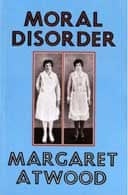Moral Disorder
by Margaret Atwood
260pp, Bloomsbury, £15.99
Most collections of short stories by a single author are grab-bags, but some approach or achieve real unity; this is a different unity from that of the novel, and deserves some attention. The gaps between stories preclude the supporting structures of conventional plot. If the stories tell a story, it must be read in glimpses, and through the gaps - a risky gambit, but one that offers singular freedom of movement and ironic opportunity. In such episodic narratives, character, place or theme replace plot as unifying elements. Many collections that pretend to unity merely fake it, but we need a name for a book that is truly a story told in stories. Could we call it a story suite?
Moral Disorder is such a suite, consisting of 11 short stories. Place, perhaps the commonest cement of the story suite, is not very important, but the stories have a single protagonist, a central character- or I think they do. She is variable, elusive, even a bit slippery. This is, after all, a book by Margaret Atwood.
Seven of the stories are told by an "I" who remains nameless, four from the third-person point of view of "Nell". It's easy to project Nell into all the stories, because they run in chronological order from childhood to age, the central figure is always female, and there are definite clues that Nell is the protagonist even when not named. Such clues are needed, for there isn't very much in the first-person stories of childhood and adolescence to connect the girl to the woman Nell. The last two stories concern a woman's experience with her father entering dementia, her mother in extreme old age. The daughter may well be Nell, the parents may be the parents of the child in the earlier stories, but I had no feeling of recognition, of rejoining the same people at a later stage of life. The book did not quite form a whole for me, an architecture, a life story however episodic. The glimpses are brilliant, but the gaps are wide. What the stories do have in common, though, is a clear eye, a fine wit, and a command of language so complete it's invisible except when it's dazzling.
One piece is dramatically and effectively out of place. Starting with the second story, we follow Nell through the years from her childhood with sister and parents, through the vicissitudes of semi-marriage, the trials of amateur farming and late parenthood, and at last to her middle age, the daughter of parents at the edge of death. But the first story in the book is chronologically the last, a portrait of Nell and her partner Tig in their own old age, when they are the parents on the edge of death. Why this reversal works so well I don't know; perhaps because "The Bad News" is a stunning opener, electric with wit, energy, Atwood's achingly keen sense of fear and pain. She has never been sharper, dryer, funnier, sadder. And there was wisdom in not putting this story last, because the last two are about dying, the end, and this one isn't, quite - not yet. "Not yet is aspirated, like the h in honour. It's the silent not yet. We don't say it out loud.
"These are the tenses that define us now: past tense, back then; future tense, not yet. We live in the small window between them, the space we've only recently come to think of as still, and really it's no smaller than anyone else's window."
The uncomplaining, absolute accuracy of this is most admirable. "The Bad News" really has some news for its readers.
None of the other stories entirely escapes conventionality, not a word I'd expect to use about Atwood. The subjects are familiar tropes of the current short story: miseries and confusions of childhood, city people learning life on a subsistence farm, dysfunctional family members, Alzheimer's. They are not quite predictable, but near it, though there is a patience, a kindness in the tone which is not common. Apart from in that first story, Atwood doesn't pull any of the surprises, the narrative flights and dodges she's so good at. There the old Canadian couple morph quietly into an old Roman couple in a small Gallic town called Glanum, which Nell and Tig once visited as tourists. Breakfast is good whether in Toronto or Glanum, but the world is not in good shape. Terrorism, barbarians threaten the empire. The news is all bad - the news is always the same and always bad, and what are two old people supposed to do about it? This gentle, plausible slide into a fantasy that deepens reality is Atwood at her slyest and sweetest. There really is nobody like her.
· Ursula K Le Guin's City of Illusions will be published in paperback by Gollancz later this year.
· To order Moral Disorder for £14.99 with free UK p&p call Guardian book service on 0870 836 0875 or go to theguardian.com/bookshop
